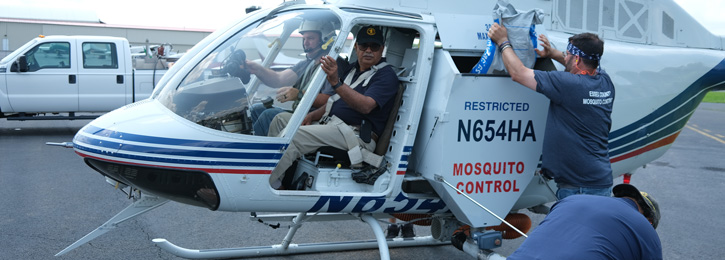With an IPM strategy, control efforts focus primarily on the immature, water-borne stages of the mosquito. The immature stages are generally confined to an aquatic microhabitat and are easier to treat since they cannot escape control measures.
Our inspectors are in the field on a daily basis during the mosquito season, searching for areas across the county that produces mosquito larvae. Common habitats can range from naturally occurring floodplains and woodland pools, to more artificial habitats such as abandoned swimming pools and small containers (like a birdbath, or children’s toys) found around the home.
The primary insecticide used to control the immature stage is a biorational (a biological pesticide of natural origin that has limited or no adverse effects on the environment or other beneficial organisms) larvicide. It uses a bacteria called Bacillus thuringiensis israelensis (Bti) to specifically target mosquito larvae. Another target specific larvicide uses the bacterium Bacillus sphaericus (Bs) for the same purpose. Chemical control measures are also taken by using an organophosphate larvicide on older larvae that no longer feed. A petroleum oil derivative is also used from time to time, mainly as a pupacide in aquatic habitats.
Biological control measures are also taken by utilizing natural predators or parasites to eliminate or control the target pest. Different fish species were used to control larval populations in enclosed aquatic habitats. The state of New Jersey has established a statewide program that uses resources from the Division of Fish and Game to provide mosquitofish, (Gambusia affinis), to counties as needed. In addition to Gambusia, the program also offers other species of fish for mosquito control, including the fathead minnow (Pimephales promelas), freshwater killfish (Fundulus diaphanus), pumpkinseed sunfish (Lepomis gibbosus), and bluegill sunfish (Lepomis macrochirus), for biological control in areas where the mosquitofish cannot be released.
While most mosquito control is done by our inspectors on a small scale basis, there are times during the season that larger areas are flooded and cannot be treated by hand. During these events, the Division will join forces with the Morris County Mosquito Extermination Commission, and using services provided by the New Jersey State Mosquito Control Commission, we are able to survey or treat large areas by air using a helicopter.
Every treatment is overseen by a mosquito inspector flying along with the pilot and inspectors on the ground responsible for ensuring proper a proper application of larvicides to the area.
When unusually large numbers of adult mosquitoes are present and public health is threatened, as a last resort a synthetic pyrethroid is used as an adulticide. Adulticide applications (spraying) are conducted when biting adult mosquito populations exceed public health or nuisance thresholds. These applications are conducted via truck-mounted ultra low-volume cold aerosol sprayers during late evening or early morning hours.
All pesticide applications the Division utilizes comply with guidelines recommended for mosquito control in New Jersey by the Agricultural Experiment Station of Rutgers Universityand regulations set forth by the NJ Department of Environmental Protection.
Below is the complete list of our products with accompanying labels, MSDS sheets, and factsheets.
Category |
Trade Name |
Active Ingredient |
Class |
Uses |
Label |
Materials Safety Data Sheet |
Chemical |
Anvil |
Sumithrin |
Pyrethroid |
Adulticide |
Label |
MSDS |
AquaReslin |
Permethrin |
Pyrethroid |
Adulticide |
Label |
MSDS |
Fyfanon |
Malathion |
Organophosphate |
Adulticide |
Label |
MSDS |
Scourge |
Resmethrin |
Pyrethroid |
Adulticide |
Label |
MSDS |
Zenivex |
Etofenprox |
Pyrethroid |
Adulticide |
Label |
MSDS |
Abate |
Tememphos |
Organophosphate |
Larvicide |
Label |
MSDS |
Golden Bear |
Proprietary oil |
Surfactant |
Larvicide / Pupacide |
Label |
MSDS |
Biorational |
Altosid |
Methoprene |
Insect growth regulator |
Larvicide |
Label |
MSDS |
Aquabac |
Bacillus thuringiensis var israelensis |
Bacterial |
Larvicide |
Label |
MSDS |
Vectobac |
Bacillus thuringiensis var israelensis |
Bacterial |
Larvicide |
Label |
MSDS |
Biological |
Gambusia affinis |
Western Mosquitofish |
Mosquito fish |
Larvicide / Pupacide |
n/a |
n/a |
Pimephales promelas |
Fathead Minnow |
Mosquito fish |
Larvicide / Pupacide |
n/a |
n/a |
Lepomis macrochirus |
Bluegill Sunfish |
Mosquito fish |
Larvicide / Pupacide |
n/a |
n/a |
Lepomis gibbosus |
Pumpkin Seed Sunfish |
Mosquito fish |
Larvicide / Pupacide |
n/a |
n/a |
Fundulus diaphonus |
Freshwater Killifish |
Mosquito fish |
Larvicide / Pupacide |
n/a |
n/a |
